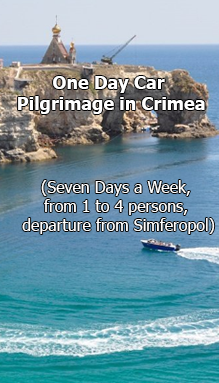Sevastopol
Sevastopol (Glorious) is a city of special administrative status. It a federal city within the Crimean Federal District. It is located in the southwestern region of the Crimean Peninsula on the Black Sea. Sevastopol is a large seaport and a naval base of Russian Fleet. Sevastopol is an industrial, scientific and cultural center of the peninsula. Its population is 342,000 people.
The territory of Sevastopol was settled in the 1st millennium BC. Homer describes the Bay of Balaklava as a port where Odysseus stayed. In Sevastopol there is the Chersonese — the Cradle of the Orthodoxy. Here still in the apostolic age many Orthodox saints led a life of asceticism. In 988 the Prince of Rus, Equal-to-the-Apostles Vladimir accepted the Holy Baptism here. The ruins of the ancient town are still protectively preserved.
Later there was a village of Akhtiyar. The commander of Russian troops in Crimea A. V. Suvorov (1730–1800) ordered to build fortifications here. The ships entered Akhtiyar on May 2, 1783. There were the first 17 warships of the Black Sea Fleet. On June 3, 1783 the first stone buildings were laid under the commander of the squadron F. F. Mackenzie. In 1824 the public garden, now Primorskiy boulevard, was laid. In 1834 the first monument of Sevastopol was set up in honour of the brig “Mercury”. The heroic defense of Sevastopol (Sep. 13, 1854 – Aug. 28, 1855) during the Crimean war made it famous. There is a monument to the scuttled ships in 1854–55.
In 1871 on the initiative of M. M. Miklukho-Maklay the Sea Biological Station was opened. In Sevastopol the electric “candle” was invented by P. N. Yablochkov. A. S. Popov installed radio stations on the battleships. In 1883 in Sevastopol battleships were built and the town became a sea fortress.
The Black Sea Fleet was the first to beat off the air attacks of the German fascists. The defence of Sevastopol lasted 250 days. On May 9, 1944 Sevastopol was liberated.
The central square of Sevastopol is Nakhimov Square. There is the Memorial Wall in honour of the heroic defense of Sevastopol in 1941–42. The Count Pier is a sea gate of Sevastopol. It was named after the commander of the Black Sea Fleet in 1840 Count Voinovich. The pier was built by the English architect John Upton.
St. Vladimir Cathedral was built in 1888 in honour of the defence of Sevastopol. There were the graves of Admirals Lazarev, Kornilov, Nakhimov and Istomin.
Sevastopol is the richest “museum city” of the Crimea. The city is famous for its museum of Chersonese, Panorama and Diorama, the common cemetery of the heroes of the 1st Defense of Sevastopol (1854–55), the Monument Temple of St. Nicholas the Miracle-Worker (1870) and many other sights.












